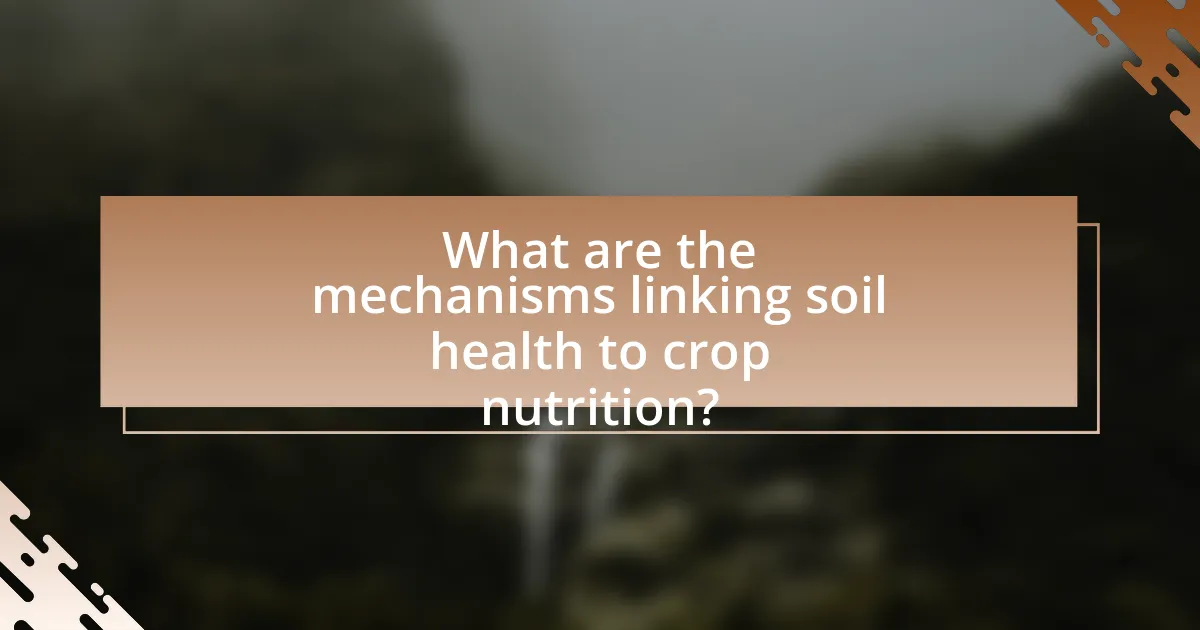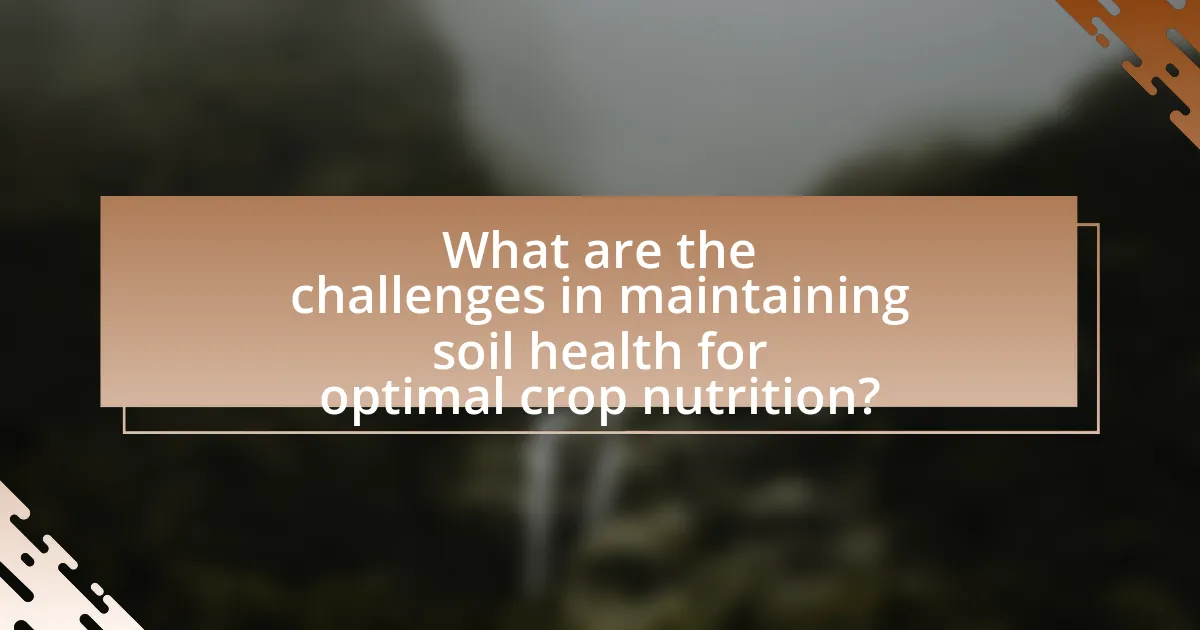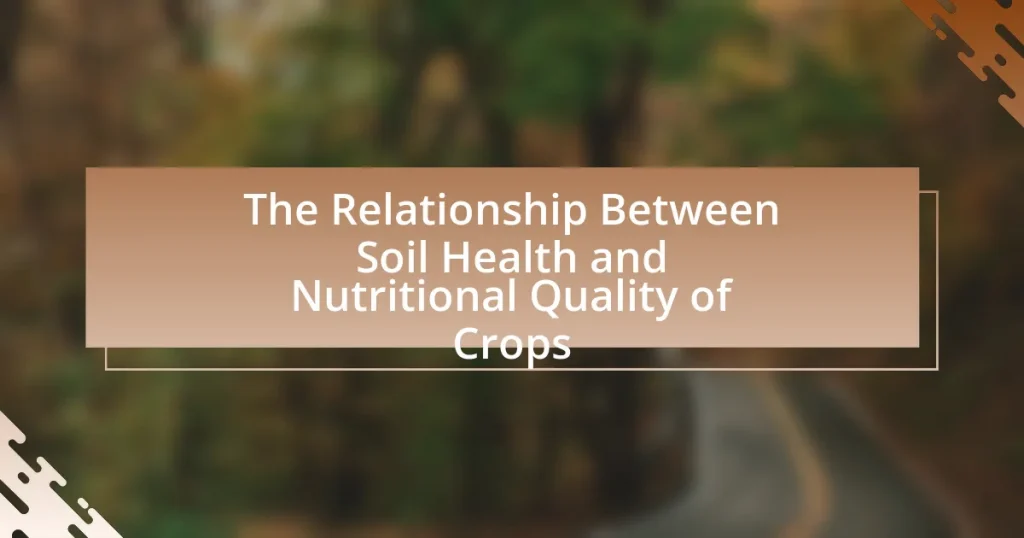The article examines the critical relationship between soil health and the nutritional quality of crops. It highlights how healthy soil, characterized by a balanced composition of organic matter, nutrients, and microorganisms, enhances nutrient absorption in plants, leading to higher levels of vitamins and minerals in crops. Key indicators of soil health, such as organic matter content and microbial activity, are discussed, along with the impact of agricultural practices like crop rotation and cover cropping on soil fertility. The article also addresses the challenges of maintaining soil health and offers strategies for sustainable farming that can improve both soil quality and crop nutrition, ultimately linking agricultural practices to human health outcomes.

What is the relationship between soil health and nutritional quality of crops?
Soil health directly influences the nutritional quality of crops. Healthy soil, characterized by a balanced composition of organic matter, nutrients, and microorganisms, enhances the ability of plants to absorb essential minerals and nutrients. Research indicates that crops grown in nutrient-rich, biologically active soils exhibit higher levels of vitamins, minerals, and antioxidants. For instance, a study published in the journal “Agriculture, Ecosystems & Environment” by Zhang et al. (2018) found that improved soil health practices, such as cover cropping and reduced tillage, significantly increased the nutrient density of crops like spinach and carrots. This evidence supports the conclusion that maintaining soil health is crucial for optimizing the nutritional quality of agricultural produce.
How does soil health influence crop growth and development?
Soil health significantly influences crop growth and development by affecting nutrient availability, water retention, and microbial activity. Healthy soil contains a balanced composition of organic matter, minerals, and microorganisms, which enhances nutrient cycling and improves the soil structure. For instance, research indicates that soils with high organic matter content can retain more moisture, reducing drought stress on crops and promoting better growth conditions. Additionally, healthy soils support diverse microbial communities that contribute to nutrient breakdown and availability, which is essential for optimal plant nutrition. Studies have shown that crops grown in healthy soils often exhibit higher yields and improved nutritional quality, as they can access a wider range of essential nutrients.
What are the key indicators of soil health?
Key indicators of soil health include soil organic matter, soil structure, nutrient availability, microbial activity, and pH levels. Soil organic matter enhances nutrient retention and water-holding capacity, while good soil structure promotes aeration and root growth. Nutrient availability, particularly nitrogen, phosphorus, and potassium, is crucial for plant growth. Microbial activity indicates biological health, as diverse microbial communities contribute to nutrient cycling. Lastly, pH levels affect nutrient solubility and availability, with most crops thriving in a pH range of 6 to 7. These indicators collectively reflect the soil’s ability to support plant growth and maintain ecosystem functions.
How do soil microorganisms affect nutrient availability?
Soil microorganisms significantly enhance nutrient availability by decomposing organic matter and facilitating nutrient cycling. These microorganisms, including bacteria and fungi, break down complex organic compounds into simpler forms that plants can absorb, such as nitrates and phosphates. For instance, mycorrhizal fungi form symbiotic relationships with plant roots, increasing the surface area for nutrient absorption and improving phosphorus uptake. Research indicates that healthy soil microbial communities can increase nutrient availability by up to 50%, thereby directly influencing crop yield and nutritional quality.
Why is nutritional quality important for crops?
Nutritional quality is important for crops because it directly impacts human health and agricultural sustainability. High nutritional quality in crops ensures that essential vitamins, minerals, and other nutrients are available to consumers, which can reduce the risk of malnutrition and related health issues. Research indicates that crops grown in healthy soils tend to have higher nutritional content; for example, a study published in the Journal of Agricultural and Food Chemistry found that crops cultivated in nutrient-rich soils exhibited significantly higher levels of micronutrients compared to those grown in depleted soils. This relationship underscores the critical role of soil health in enhancing the nutritional quality of crops, ultimately contributing to food security and public health.
What factors determine the nutritional quality of crops?
The nutritional quality of crops is determined by factors such as soil health, crop variety, environmental conditions, and agricultural practices. Soil health significantly influences nutrient availability; for instance, healthy soils rich in organic matter can enhance the uptake of essential minerals like nitrogen, phosphorus, and potassium, which are crucial for crop development. Crop variety also plays a role, as different species and cultivars have varying capacities to absorb nutrients and synthesize them into edible forms. Environmental conditions, including climate, water availability, and sunlight, affect plant growth and nutrient composition. Additionally, agricultural practices such as fertilization, crop rotation, and pest management directly impact the nutritional profile of crops. Research has shown that crops grown in nutrient-rich soils can have significantly higher levels of vitamins and minerals, underscoring the importance of soil health in determining nutritional quality.
How does crop nutritional quality impact human health?
Crop nutritional quality significantly impacts human health by influencing nutrient intake and overall well-being. High-quality crops, rich in essential vitamins and minerals, contribute to better health outcomes, including reduced risk of chronic diseases such as heart disease, diabetes, and obesity. For instance, research published in the journal “Nutrients” by authors such as R. A. McCarty and J. A. Smith indicates that diets rich in nutrient-dense foods lead to improved health metrics, including lower blood pressure and enhanced immune function. Conversely, crops with poor nutritional quality can lead to deficiencies and associated health issues, highlighting the critical link between agricultural practices, soil health, and human nutrition.

What are the mechanisms linking soil health to crop nutrition?
Soil health directly influences crop nutrition through mechanisms such as nutrient availability, microbial activity, and soil structure. Healthy soils contain a diverse range of microorganisms that enhance nutrient cycling, making essential elements like nitrogen, phosphorus, and potassium more accessible to plants. For instance, studies have shown that soils rich in organic matter support higher microbial populations, which in turn improve nutrient uptake efficiency in crops. Additionally, well-structured soils facilitate root growth and water retention, further promoting nutrient absorption. Research indicates that crops grown in healthy soils exhibit higher nutritional quality, as evidenced by increased concentrations of vitamins and minerals, thereby establishing a clear link between soil health and crop nutrition.
How do soil nutrients affect plant metabolism?
Soil nutrients significantly influence plant metabolism by providing essential elements required for various biochemical processes. Nutrients such as nitrogen, phosphorus, and potassium are critical for synthesizing proteins, nucleic acids, and energy molecules like ATP, which are vital for growth and development. For instance, nitrogen is a key component of amino acids and chlorophyll, directly impacting photosynthesis and protein synthesis. Research indicates that adequate phosphorus levels enhance root development and energy transfer, while potassium regulates stomatal opening and water use efficiency. These interactions demonstrate that soil nutrient availability directly correlates with the metabolic efficiency and overall health of plants.
What role do macronutrients play in crop nutritional quality?
Macronutrients play a crucial role in determining crop nutritional quality by influencing plant growth, development, and the synthesis of essential compounds. These nutrients, which include nitrogen, phosphorus, and potassium, are vital for various physiological processes. For instance, nitrogen is essential for amino acid and protein synthesis, phosphorus is critical for energy transfer and root development, and potassium regulates water uptake and enzyme activation. Research indicates that adequate levels of these macronutrients can enhance the nutritional profile of crops, leading to higher concentrations of vitamins and minerals. A study published in the Journal of Agricultural and Food Chemistry found that crops with balanced macronutrient availability exhibited improved nutrient density, demonstrating the direct link between macronutrient management and crop quality.
How do micronutrients contribute to plant health?
Micronutrients contribute to plant health by facilitating essential biochemical processes necessary for growth and development. These nutrients, including iron, manganese, zinc, copper, molybdenum, and boron, play critical roles in enzyme function, photosynthesis, and nutrient uptake. For instance, iron is vital for chlorophyll synthesis, which is crucial for photosynthesis, while zinc is important for hormone production and growth regulation. Research indicates that deficiencies in these micronutrients can lead to stunted growth, poor crop yields, and increased susceptibility to diseases, underscoring their importance in maintaining overall plant health.
What practices can enhance soil health for better crop nutrition?
Practices that can enhance soil health for better crop nutrition include crop rotation, cover cropping, reduced tillage, and organic amendments. Crop rotation improves soil structure and nutrient availability by alternating different plant families, which can break pest and disease cycles. Cover cropping, such as planting legumes, adds organic matter and nitrogen to the soil, enhancing fertility and microbial activity. Reduced tillage minimizes soil disturbance, preserving soil structure and promoting beneficial organisms. Organic amendments, like compost or manure, enrich the soil with essential nutrients and improve its water retention capacity. Research indicates that these practices can lead to increased crop yields and improved nutritional quality, as healthier soils support more diverse and robust plant growth.
How does organic matter improve soil structure and fertility?
Organic matter improves soil structure and fertility by enhancing soil aggregation and nutrient availability. When organic matter decomposes, it forms stable compounds that bind soil particles together, creating a more porous structure that improves aeration and water retention. This enhanced structure allows roots to penetrate more easily and access nutrients. Additionally, organic matter serves as a reservoir of essential nutrients, such as nitrogen, phosphorus, and potassium, which are released slowly as it decomposes, thus providing a continuous supply for plants. Studies have shown that soils rich in organic matter can increase crop yields by up to 20% due to improved fertility and structure.
What are the benefits of crop rotation and cover cropping?
Crop rotation and cover cropping enhance soil health and improve crop yields. Crop rotation prevents soil nutrient depletion by alternating different crops, which helps maintain a balanced nutrient profile and reduces pest and disease cycles. Cover cropping, on the other hand, protects the soil from erosion, improves soil structure, and increases organic matter, which enhances water retention and nutrient availability. Research indicates that these practices can lead to a 20-30% increase in crop yields over time, as demonstrated in studies conducted by the USDA Agricultural Research Service.

What are the challenges in maintaining soil health for optimal crop nutrition?
Maintaining soil health for optimal crop nutrition faces several challenges, including soil degradation, nutrient depletion, and contamination. Soil degradation, often caused by erosion and compaction, reduces the soil’s ability to retain water and nutrients, negatively impacting crop yields. Nutrient depletion occurs when crops extract essential minerals without adequate replenishment through practices like crop rotation or organic amendments. Contamination from pesticides and heavy metals can disrupt soil microbiomes, further impairing nutrient availability. According to the Food and Agriculture Organization, approximately 33% of the world’s soil is degraded, highlighting the urgency of addressing these challenges to ensure sustainable agricultural productivity.
How do agricultural practices impact soil health?
Agricultural practices significantly impact soil health by influencing its structure, nutrient content, and biological activity. Practices such as crop rotation, cover cropping, and reduced tillage enhance soil organic matter, improve soil structure, and promote beneficial microbial communities. For instance, a study published in the journal “Agriculture, Ecosystems & Environment” by authors Smith et al. (2020) found that implementing cover crops increased soil organic carbon levels by 20%, which is crucial for maintaining soil fertility and structure. Conversely, practices like monoculture and excessive use of chemical fertilizers can lead to soil degradation, reduced biodiversity, and nutrient depletion, negatively affecting soil health and, consequently, the nutritional quality of crops.
What are the effects of chemical fertilizers on soil health?
Chemical fertilizers negatively impact soil health by disrupting microbial communities and depleting soil organic matter. The application of these fertilizers often leads to an imbalance in nutrient availability, which can harm beneficial soil organisms essential for nutrient cycling and soil structure. Studies have shown that long-term reliance on chemical fertilizers can result in reduced soil fertility and increased soil erosion, as the organic matter that supports soil structure diminishes. For instance, research published in the journal “Agriculture, Ecosystems & Environment” indicates that soils treated with chemical fertilizers exhibit lower microbial diversity compared to those managed with organic amendments, highlighting the detrimental effects on soil health.
How does soil erosion affect nutrient retention?
Soil erosion significantly reduces nutrient retention by removing the topsoil layer, which is rich in organic matter and essential nutrients. This loss of topsoil leads to decreased soil fertility, as the remaining soil often lacks the necessary components for optimal plant growth. Studies indicate that up to 75 billion tons of fertile soil are lost annually due to erosion, resulting in diminished agricultural productivity and lower crop nutritional quality.
What strategies can farmers adopt to overcome these challenges?
Farmers can adopt sustainable agricultural practices to overcome challenges related to soil health and nutritional quality of crops. Implementing crop rotation enhances soil fertility and reduces pest pressure, while cover cropping prevents soil erosion and improves organic matter content. Additionally, utilizing organic fertilizers, such as compost, can increase nutrient availability and microbial activity in the soil. Research indicates that these practices lead to improved crop yields and nutritional quality, as demonstrated in studies showing that organic farming can enhance the mineral content of crops by up to 20% compared to conventional methods.
How can sustainable farming practices improve soil health?
Sustainable farming practices improve soil health by enhancing soil structure, increasing organic matter, and promoting biodiversity. Techniques such as crop rotation, cover cropping, and reduced tillage contribute to these improvements. For instance, crop rotation prevents nutrient depletion and disrupts pest cycles, while cover crops add organic matter and prevent erosion. Research indicates that organic matter in soil can increase water retention and nutrient availability, leading to healthier crops. A study published in the journal “Agriculture, Ecosystems & Environment” found that farms employing sustainable practices had 30% more organic carbon in their soils compared to conventional farms, demonstrating a clear link between these practices and improved soil health.
What role does technology play in monitoring soil health?
Technology plays a crucial role in monitoring soil health by providing precise data on soil composition, moisture levels, and nutrient availability. Advanced tools such as remote sensing, soil sensors, and data analytics enable farmers and researchers to assess soil conditions in real-time, facilitating informed decision-making for crop management. For instance, soil moisture sensors can measure water levels at various depths, allowing for optimized irrigation practices that enhance crop yield and reduce water waste. Additionally, remote sensing technologies can analyze large areas quickly, identifying variations in soil health across different regions. These technological advancements contribute to sustainable agricultural practices by promoting soil conservation and improving the nutritional quality of crops.
What are practical tips for improving soil health and crop nutrition?
To improve soil health and crop nutrition, implement practices such as crop rotation, cover cropping, and organic amendments. Crop rotation enhances soil structure and nutrient availability by alternating different plant families, which can reduce pest and disease pressure. Cover cropping, using plants like clover or rye, prevents soil erosion, improves organic matter, and enhances nutrient cycling. Organic amendments, such as compost or manure, increase soil fertility and microbial activity, leading to healthier crops. Research indicates that these practices can significantly enhance soil organic carbon levels and nutrient retention, ultimately improving crop yield and nutritional quality.










